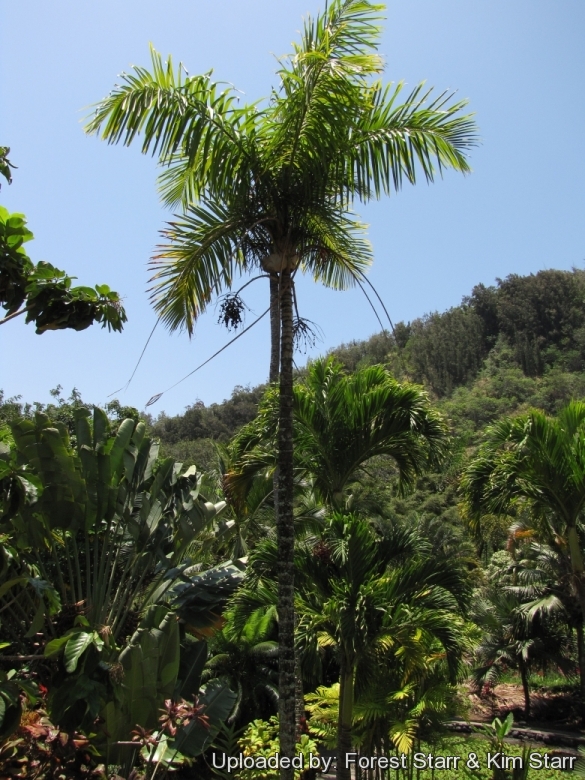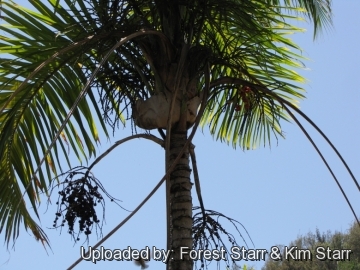




Your support is critical to our success.

Habit at Iao Tropical Gardens of Maui, Maui, Hawaii (USA). May 22, 2012.
Origin and Habitat: Mexico (Quintana Roo), Guatemala (Petén), and Belize
Habit and ecology: Gaussia mayaSN|28498]]SN|28498]] is a forest species, scattered in rocky places on limestone soils, at low elevations. The population size is small and is threatened by habitat destruction and degradation.
Synonyms:
- Gaussia maya (O.F.Cook) H.J.Quero & Read
- Opsiandra maya O.F.Cook
ENGLISH: llumepalm, Maya palm
FRENCH (Français): Gaussia des Mayas
SPANISH (Español): Cambo, La palma, Palma cimarrona, Palmasito, Kambo
Description: The Maya palm, Gaussia mayaSN|28498]]SN|28498]], is a solitary elegant palm species with a rather small, untidy head of leaves and prominently ringed trunk. The grass-green leaflets are arranged in many planes, giving the leaves a plume-like appearance which helps offset their small number (It tends to only hold 3-4 leaves at a time). Maya palm does have a reputation for blowing over in high winds.
Stems: Almost columnar, often leaning, 5-20 m tall and 10-15(-30) cm diameter, grey. The early swollen base is distinctive. Then, miraculously, this bulge shrinks as the palm matures, eventually giving a somewhat thin-trunked palm.
Leaves (fronds): 3-8 in a crown, pinnate (feather shaped) erect from the trunk and spirally arranged, 2-3 m long and arching. Leaflets linear-lanceolate, 3-4 cm wide, regularly arranged in 4 ranks along the rachis, but spreading in different planes.
Inflorescences: Up to a dozen on a plant at any one time, branched 1-2 orders. The first inflorescences of the maya palm remain in bud for several years as the trunk continues to grow, producing additional inflorescences above them. At some point, old and young buds begin to open sequentially from oldest to youngest, with the result that maya palms usually carry flowers and fruits at the same time and at all stages of development.
Flowers: Flowers are arranged in a three flowered partial inflorescence called an acervulus (a distinctive flower cluster found only in the chamaedoreoid group of palms), and so resembles the triad superficially, but the position and anatomy of the flowers differ from those of the triad and indicate a basic similarity to the acervulus. The acervolus has so far not been reported elsewhere in the largest palm subfamily Arecoideae, which is traditionally characterized by flowers predominantly arranged in triads of one central female and two lateral male flowers.
Fruits: Globose or bilobed, 1-1.5 cm diameter, bright red.
Bibliography: Major references and further lectures
1) M.M. Grandtner “Elsevier's Dictionary of Trees: Volume 1: North America” Volume 1 Elsevier, 08/Apr/2005
2) Forest & Kim Starr Gaussia maya (Gaussia). Plants of Hawaii. <http://www.starrenvironmental.com>. Downloaded on 21 August 2014.
3) Andrew Henderson “Field Guide to the Palms of the Americas” Princeton University Press, 1997
4) Quero, H.J. 1998. Gaussia maya. The IUCN Red List of Threatened Species. Version 2014.2. <www.iucnredlist.org>. Downloaded on 28 August 2014.
5) N. Ortega-Chávez and F. W. Stauffer “Ontogeny and structure of the acervulate partial inflorescence in Hyophorbe lagenicaulis (Arecaceae; Arecoideae)” in: Ann Bot (2011) First published online: June 28, 2011
6) Natalie W. Uhl and Harold E. Moore Jr. “The Structure of the Acervulus, the Flower Cluster of Chamaedoreoid Palms” American Journal of Botany Vol. 65, No. 2, Feb., 1978
7) John Dransfield, Natalie W. Uhl “Genera Palmarum: the evolution and classification of palms” Kew Pub., 2008
8) Wikipedia contributors. "Gaussia maya" Wikipedia, The Free Encyclopedia. Wikipedia, The Free Encyclopedia, 21 Aug. 2014. Web. 28 Aug. 2014.
9) Don Ellison, Anthony Ellison “Cultivated Palms Of The World” UNSW Press, 01/May/2001
10) Robert Lee Riffle, Paul Craft “An Encyclopedia of Cultivated Palms” Timber Press, Portland 2007
11) Palmpedia contributors. "Gaussia maya." Palmpedia, PALM ENCYCLOPEDIA, <http://www.palmpedia.net> Downloaded on 26 Aug. 2014
12) Jones, D. L. “Palms throughout the world.” 1994 Floridata contributors. "Gaussia maya ." Floridata, <http://www.floridata.com> Accessed on 26 Aug. 2014
13) "Gaussia maya." PACSOA Palms and Cycads wiki , <http://www.pacsoa.org.au> Accessed on 26 Aug. 2014

Crown at Iao Tropical Gardens of Maui, Maui, Hawaii (USA). May 22, 2012. Photo by: Forest Starr & Kim Starr

Fruit at Iao Tropical Gardens of Maui, Maui, Hawaii (USA). May 22, 2012. Photo by: Forest Starr & Kim Starr
Cultivation and Propagation: Gaussia mayaSN|28498]]SN|28498]] is a nice addition to warm and humid tropical and subtropical gardens, that does well in cultivation. It makes an attractive specimen despite its relatively sparse crown of ascending leaves, but some people say that this species is unattractive because most plants generate only 3-4 leaf at a time. Requires warmth and a steady supply of moisture for best growth, but is quite tolerant of a wide range of soil types. Not often offered for sale, and should be more widely grown.
Growth rate: It is little slow to take off but once established will grow quite fast. If kept moist and fertilized regularly, the growth will be rapid.
Soil requirements: It prefers well-drained fertile, soils except those that are constantly soggy. However it is widely adaptable and can even thrives in poor soils, but do better when grown in alkaline, nutrient-rich soils with regular watering.
Watering: It prefers moist soils (not saturated). This palm a will tolerate occasional dryness if not prolonged. Don't let sit in water. .
Light:It will tolerate full sun, but looks best if situated in part shade, and gives best results if it receives shade from midday sun but is fully exposed to the morning sun. Leaves yellow and burn in the hot sun. It likes a shady, moist, well drained position as a youngster, but can take more sun as it grows. If home-grown, give some sun as with most tropical palms.
Fertilization: Need a perfect fertilizer diet including all micro nutrients and trace elements. It is subject to potassium deficiency
Aerosol salt tolerance: It is moderately salt tolerant, but does a lot better inland then it does on the coast.
Hardiness: USDA Zones 10-12, severely damaged or killed at -3 degrees C.
Wind hardiness: It can tolerate sweltering heat and moderately windy conditions.
Propagation: The seeds germinate easily when fresh.. If not properly treated, the seed does not have long shelf life.
Ornamental use: It is grown as an ornamental plant in gardens in tropical and subtropical regions, and elsewhere indoors.
Traditional uses: The long-lasting stems are used for construction.
Food uses: The palm heart is an excellent vegetable and the fruits are edible.
Disease & Pests: It is quite resistant to pests but may require regular fertilization to prevent yellowing caused by potassium deficiencies; protect against frost.
| Your Actions | |
|---|---|
| Back to Gaussia index | |
| Back to Arecaceae index | |
 |
Back to Palms And Cycads Encyclopedia index |
Privacy stantement - Terms and conditions - How to cite - About us - Feedback - Donate



